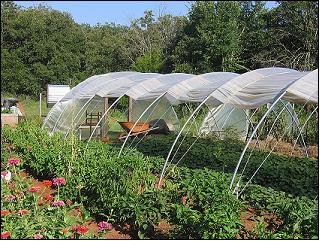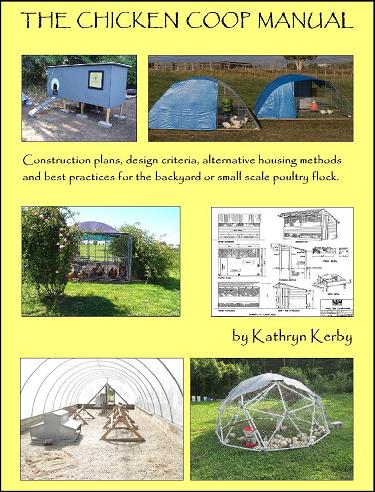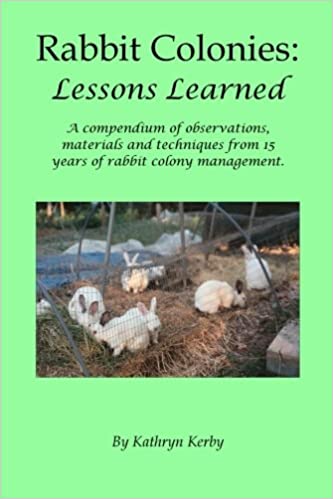|
Search this site for keywords or topics..... | ||

Custom Search
| ||
Season Extenders Summary
for Farm and Garden

This season extenders summary is dedicated to anyone who wants to get going earlier in springtime, grow later into the fall, perhaps grow and/or harvest during the winter, or all the above. And that applies to most of the growers we know. If you grow produce for sale, you might also need that income sooner, and wish it lasted longer. That is exactly what season extension methods do - give us that longer, more reliable, more predictable growing season that we all wished we had.
So the question of whether the growing season can be extended is simple - of course it can. The real question is whether we take advantage of these methods, and how best to do so. There are many ways to extend the growing season, from inexpensive and low-tech methods to extend growing just a few weeks, to high-cost fully automated climate control to grow orchids in winter. Many of these season extension options can be combined, such that you have multiple layers of protective environment around your high-value market plants. Whether you're a hobbyist, growing for a farmer's market or CSA, or selling your produce wholesale, it may be cost effective for you to explore one or more of these season extension options. This section of the website will try to provide comprehensive information about current season extenders, and answer the most common questions about those options.
The following table is a summary of season extender methods, ranging from lightweight and/or temporary methods, up to more costly, complex and/or permanent methods. Please see the hyperlinks to read more about each type of protection.
| Season Extension Type | Temp Change (deg. F) | Common Uses | Cost | Complexity | Durability |
|---|---|---|---|---|---|
| Floating Row Cover | 5 | Severe weather protection for cool-hardy crops. | Low | Low | 1-3 Years |
| Cold Frames | 10-20 | Germination boost and severe weather protection for cool-hardy crops. | Low | Low to Moderate | 1-5 Years |
| Hot Frames | 20 | Germation boost and severe weather protection for tender seedlings. | Low to moderate | Low to moderate | 1-5 years depending on heat source |
| Soil Heating Cables | 5-20 | Germination boost and accelerated growing for high value seedlings. | Moderate | Moderate | 3-10 years |
| Low Tunnels | 10-20 | Early/Late season protection for all crops; allows for all-season harvest. | Low to Moderate | Low | 3-5 years |
| High Tunnels | 10-40 | Early/late season protection for all crops, with walk-in access and fewer thermal swings; allows for all-season harvest. | Low to moderate | Low to moderate | 3-5 years |
| Germination cabinets | 30-50 | Germination boost and humidity control for tender seedlings. | Moderate | Moderate to High | 5-10 years |
| Reemay in hoophouses | 5 | Provides extra buffer against extreme cold snaps. | Low | Low | Indefinite |
| Unheated greenhouse | 10-40 | Early/late season protection for all crops, with easier access and fewer thermal swings; allows for all-season harvest. | Moderate to High | Moderate | 5-10 Years |
| Heated Benches | 20-40 | Germination boost and accelerated growing for high value seedlings. | Moderate to High | Moderate | 5-10 years |
| seedling tray covers | 10-30 | Germination boost and humidity control for tender seedlings. | Low to moderate | Low to moderate | 5-10 years |
| Heating Mats | 20-40 | Germination boost and accelerated growing for high value seedlings. | Low to Moderate | Low to moderate | 5-10 years |
| Heated Greenhouse | 20-50 | Early/Late season protection for all crops, with easier access and fewer thermal swings; allows for all-season harvest. | High | Moderate to High | 10-20 years with replacement film |
| Heated, passively ventilated greenhouse | 20-50, ceilings on high temps | Early/late season protection for all crops, with easier access and fewer thermal swings; allows for all-season harvest. Controls buildup of heat and humidity, reduces heat stress and humidity-linked diseases/pests. | High | Moderate to High | 10-20 years with maintenance |
| Heated, actively ventilated greenhouse | 20-50, ceilings on high temps | Early/late season protection for all crops, with easier access and fewer thermal swings; allows for all-season harvest. Controls buildup of heat and humidity, reduces heat stress and humidity-linked diseases/pests. | Very High | High | 10-20 years with maintenance |
| Heated, actively ventilated, artificially lighted greenhouse | 20-50, ceilings on high temps | Early/late season protection for all crops, with easier access and fewer thermal swings; allows for all-season harvest. Controls buildup of humidity and humidity-linked disease/pests. Supplemental heat and light allows for year-round growing and harvesting. | High | Moderate to High | 10-20 years with maintenance |
Season Extenders Details
The above is a tremendous amount of information to digest, and it’s taken awhile to compile just the summary table. Over the next few weeks I’ll be working to flesh out this season extender summary, with a page dedicated to each different season extension method. Once each page is done, I’ll provide a hyperlink from the extension method name listed above, to the actual page. Eventually the entire table will be fully linked and crossed-referenced with additional sources of information. Please have patience as we work through all that information and get it published.
I hope somewhere in this season extender summary you found some answers to your own growing needs. We are continually looking for more options in season extenders, and new options are presenting themselves all the time. If you hear of some season extension method that we haven’t covered, let us know and we’ll add it to the list above, with a complete review. If you have more questions about one of the options already listed, let us know and we’ll look at answering those questions. This website exists to help you with your growing goals. Let us know if there’s any other way we can help you achieve those goals.
Additional Resources
Many extension offices, land grant universities and farming/gardening non-profit organizations have additional educational information about growing season extenders. Not all of the following will have all the options listed above. But each of them will go into quite a bit of detail about at least some of them. Here are just a few of them:
University of Alaska-Fairbanks has done extensive research on season extenders, which makes sense given Alaska's amazingly short growing season. Their Greenhouses and Season Extenders publication, available in free PDF download, is a wonderful resource.
Virginia Cooperative Extension has a similar pdf download for folks growing in the mid-Atlantic region. Even with those milder conditions, their Season Extenders publication provides a lot of good hints for making the most of that climate.
Clemson University has released the Season Extension Techniques for Market Gardeners guide specifically for market gardeners. This substantial (42 pages!) guide specifically addresses the needs of small scale commercial production growers, and their sometimes unique requirements and challenges. Included in this guide are reprints of other season extender articles from other sources.
Another wonderful guide called Season Extension Tools and Techniques was released by the University of Kentucky. This guide is also substantial, and provides information not only on the available equipment options but also how best to use them. This guide also had an extensive list of additional resources.
Ongoing Research
We are always looking for additional research materials, even as we continue our own work. If you have a favorite guide to equipment, techniques or methods which we don't cover above, Contact Us with the details and we'll add it to the above lists.
Our Successful Farming and Ranching Books

We released our very first self-published book. The Chicken Coop Manual in 2014. It is a full color guide to conventional and alternative poultry housing options, including 8 conventional stud construction plans, 12 alternative housing methods, and almost 20 different design features. This book is available on Amazon.com and as a PDF download. Please visit The Chicken Coop Manual page for more information.

Rabbit Colonies: Lessons Learned
We started with rabbits in 2002, and we've been experimenting with colony management ever since. Fast forward to 2017, when I decided to write another book, this time about colony management. The book is chock-full of practical information, and is available from both Amazon and as a PDF download. Please visit the Rabbit Colonies page for more information.
The Pastured Pig Handbook
We are currently working on our next self-published book: The Pastured Pig Handbook. This particular book addresses a profitable, popular and successful hog management approach which sadly is not yet well documented. Our handbook, will cover all the various issues involved with pastured hog management, including case studies of numerous current pastured pig operations. If you have any questions about this book, please Contact Us.